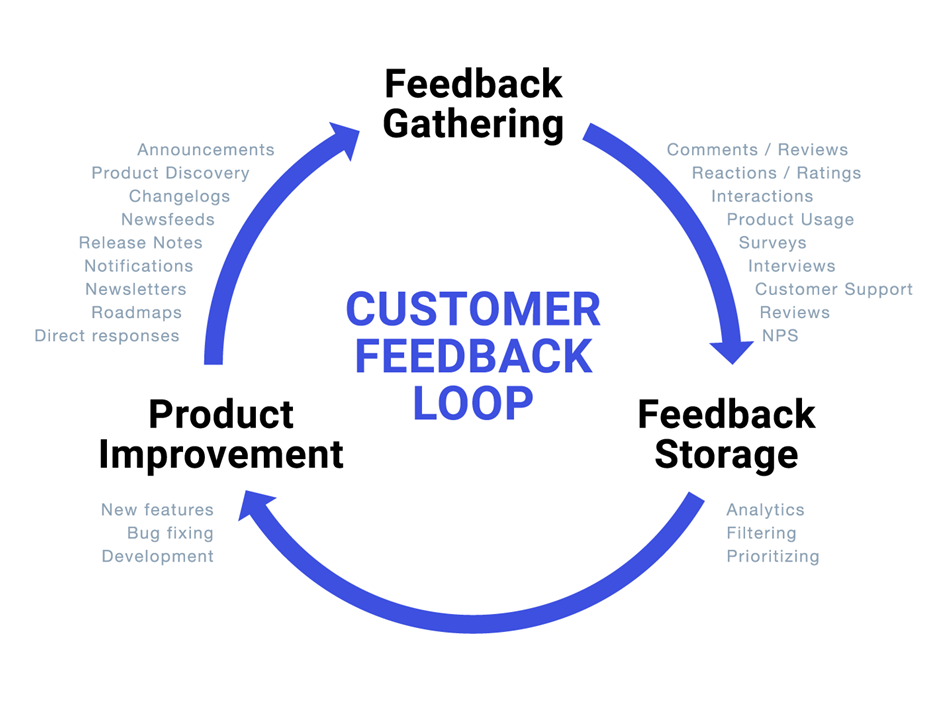As a product manager, you know that user feedback is essential to the success of your product. But how do you make sure that you’re getting the right kind of feedback, and using it to make the best decisions for your product? In this post, we’ll discuss how to build user feedback into your product’s lifecycle, so that you can make sure that you’re always making the most of your users’ input.
What is user feedback?
In the context of product management, user feedback is any input or feedback that your users provide about your product. This can take many different forms, such as customer surveys, feature requests, usability testing, and more. In general, user feedback provides valuable insights into how well your product is meeting the needs of your users, and what you can do to improve it.
Why is user feedback so important?
As a product manager, you are responsible for making decisions that help your product succeed and grow over time. User feedback can provide you with valuable information about what your users want and need, as well as where there may be gaps or weaknesses in your product’s offering. By gathering and analyzing user feedback, you can make data-driven decisions that help your product succeed in the long term.
Building a product roadmap
One key step in building user feedback into your product’s lifecycle is building a product roadmap. A product roadmap is a strategic plan that outlines the major milestones, features, and goals for your product over time. Building a product roadmap can help you to visualize how different features or changes will affect the overall trajectory of your product, and make decisions about what to prioritize.
Understand the importance of user feedback
The first step in building user feedback into your product’s lifecycle is to recognize the importance of this kind of feedback. User feedback can help you gain valuable insights into how your users are using your product, what they like and don’t like about it, and what improvements or changes they would like to see. By carefully analyzing this feedback, you can make more informed decisions about how to improve and evolve your product over time.
Collect feedback throughout the product lifecycle
Once you have recognized the importance of user feedback, it’s important to start actively collecting this feedback as early in your product’s lifecycle as possible. One method for doing this is to set up regular surveys or questionnaires that you can send to your users, asking them for their thoughts on specific aspects of the product. You can also encourage direct feedback in other ways, such as by having an active social media presence where users can share their thoughts and suggestions.
Plan for user feedback during product development
Once you have collected initial feedback from your users, it’s important to plan how you will incorporate this feedback into future product development decisions. This may involve incorporating user suggestions directly into your product roadmap, or considering how specific changes may impact the overall experience for your users. By doing so, you can ensure that your product is always evolving and improving in response to user feedback and needs.
Promote user engagement and retention
Also, it’s important to make sure that you continue promoting user engagement and retention over the long term. This may involve implementing strategies such as gamification or other loyalty programs, which can help keep users engaged with your product and encourage them to stay involved over time. By focusing on user feedback and engagement throughout your product
Gather user feedback during beta testing
One of the most critical times to focus on user feedback is during beta testing. Once you have a working prototype or early version of your product, it’s important to gather feedback from real users as soon as possible. This can help identify any potential issues with your product, and give you valuable insights into how users are engaging with your product at an early stage.
One effective strategy for gathering user feedback during beta testing is to host focus groups or other in-person sessions, where you can observe users interacting with your product and get their candid reactions.
Another important consideration during beta testing is to actively solicit and respond to user feedback. Whether this takes the form of email surveys, social media comments, or other methods, it’s important to make sure that you are listening carefully to what your users have to say. This can help ensure that any issues or problems with your product are quickly addressed and that you can incorporate your users’ feedback into future product iterations and enhancements.
Use user feedback to improve your product’s design
Once you have implemented user feedback into your product’s design, it’s important to continue tracking and analyzing this feedback over time. You can do this by regularly reviewing analytics data or through more in-depth user surveys or focus groups. This data can help you identify areas where your users are having challenges with your product, as well as any features or functions that may be getting the most traction or engagement.
This data can also help you make more informed design decisions, such as by focusing on optimizing your product’s user onboarding flow or designing new features or functionalities based on feedback from your users.
Analyze user feedback to make future product decisions
In addition to monitoring and analyzing user feedback during product development, it’s important to continue tracking and assessing this data after your product has been released. This may involve conducting regular surveys or focus groups with specific user demographic or using analytics tools such as heat mapping software to analyze user behavior.

Case studies
The real cases where user feedback was extremely important to product development include the launch of Apple’s iPhone, which was greatly influenced by user feedback, and online food delivery service Seamless, which continues to use user feedback and surveys to continually improve their product.
Another real-world example is Google’s recent redesign of its popular Gmail service, which was based on extensive user feedback and data analysis. By incorporating this data into the redesign process, Google was able to create a more streamlined and intuitive user experience for Gmail users around the world.
And the last but not least example is Amazon, which relies heavily on user feedback to continually improve and optimize its product offerings. Whether it’s through detailed customer reviews, targeted surveys, or social media engagement, Amazon has proven that effectively gathering and using user feedback can drastically improve your product over time.
Given the importance of user feedback in product development, it is critical for any company looking to create a successful product to focus on gathering this feedback and using it to enhance their products over time. By engaging with users throughout the development process and using data-driven design decisions, companies can ensure that they are creating high-quality products that meet real user needs.
Conclusion
Overall, many different strategies can be used to incorporate user feedback into your product’s lifecycle. Some key steps include gathering feedback during beta testing, using this data to improve design and usability, and analyzing user feedback to inform future product decisions. By focusing on user feedback throughout your product journey, you can ensure that your user’s needs and preferences are always a top priority in your product development process.
Write and Win: Participate in Creative writing Contest and win fabulous prizes.















